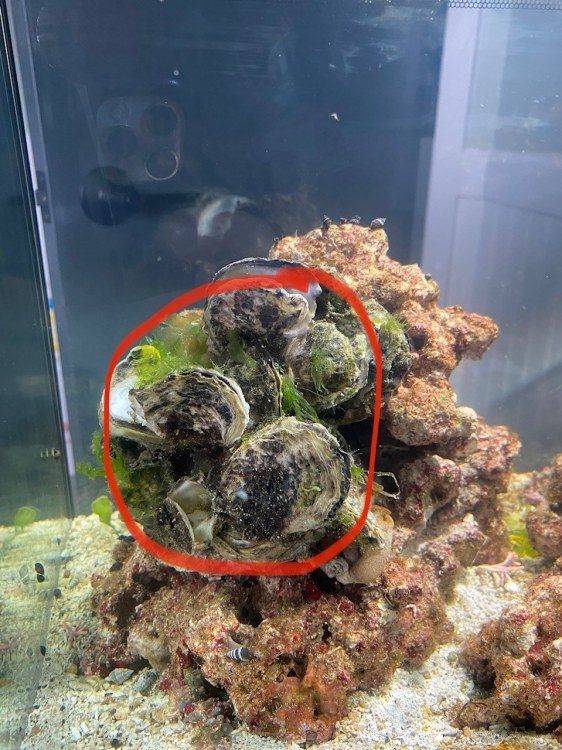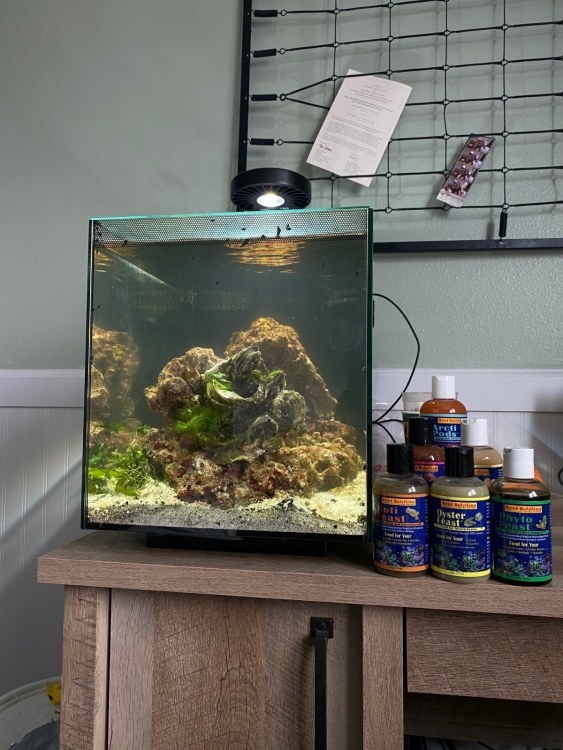Well that last post might have been in vain, I was talking with John at Reef Cleaners about finding oyster clusters and he added one to my box. That might have been a bad idea because did I spend $200 on live rock? Yes, and now do I just want to have oyster clusters? Yes I do, what will I do with my ocean rock? No idea, maybe keep the base rocks and give the larger rocks to my LFS? Who knows, NOT ME! But I just LOVE how the ulva and other macros are growing on the oyster cluster...oh and did I say SOME OF THEM ARE ALIVE!!! I think the biggest shock was that 90% of my CUC order survived even though this week in MN we have had snow/slush Monday-Wednesday.


I am doing a bit of search for care on oysters but I just love how natural and unique this tank looks with just a single cluster, so much so I asked John and a friend who is down in Florida to get me more! Anyways there were some green porcelain crabs that did not make the trip but that is okay, I can get some from John as well. With all of these new developments I think my idea of a rhino blenny and a pair of small filefish (either Radial or White-spotted) will be my livestock.
Anyways here are a few shots of the tank, and don't worry all the coralline is in my 5N goby tank at the moment until I know what I will do with it. I did also inquire with Gulf Specimen Marine Lab about getting a small (dozen shells) of their "Living Shell Assortment" the description is as follows:
"Dead oyster and clam shells are of great ecological significance on sandy bottoms where they provide a substrate for an entire community of sessile animals and plants, which either encrust or bore directly into the dead shells. By distributing one or more shells to each student, observations can be made concerning the various adaptations common to this specialized lifestyle. Some shells are covered with barnacles, others have pink and red Astrangia coral or orange bryozoans; and still others support tunicates. Sabellarid and serpulid polychaetes encrust the surface with their limestone or sandy tubes. Feather duster worms expand their crowns from within the shell. Limpets and chitons move about on the surface grazing on algae, and some shells have orange dorid nudibranchs, Doriopsilla pharpa. The juvenile stages of the boring sponge, Cliona celata, riddle the shells, dissolving away the limestone substrate. These are not just specimens; they are entire living mini-habitats"
That just sounds totally amazing! How cool would it be to get some of the Astrangia coral in my tank! I feel like this is more of what I wanted and not the Florida rock tbh, but I guess I live and learn. I did read that oysters like temps a bit cooler so I set my ink bird to be at 75 degrees instead of 78, I am curious to see how my palythoa react to the temperature change.


I am doing a bit of search for care on oysters but I just love how natural and unique this tank looks with just a single cluster, so much so I asked John and a friend who is down in Florida to get me more! Anyways there were some green porcelain crabs that did not make the trip but that is okay, I can get some from John as well. With all of these new developments I think my idea of a rhino blenny and a pair of small filefish (either Radial or White-spotted) will be my livestock.
Anyways here are a few shots of the tank, and don't worry all the coralline is in my 5N goby tank at the moment until I know what I will do with it. I did also inquire with Gulf Specimen Marine Lab about getting a small (dozen shells) of their "Living Shell Assortment" the description is as follows:
"Dead oyster and clam shells are of great ecological significance on sandy bottoms where they provide a substrate for an entire community of sessile animals and plants, which either encrust or bore directly into the dead shells. By distributing one or more shells to each student, observations can be made concerning the various adaptations common to this specialized lifestyle. Some shells are covered with barnacles, others have pink and red Astrangia coral or orange bryozoans; and still others support tunicates. Sabellarid and serpulid polychaetes encrust the surface with their limestone or sandy tubes. Feather duster worms expand their crowns from within the shell. Limpets and chitons move about on the surface grazing on algae, and some shells have orange dorid nudibranchs, Doriopsilla pharpa. The juvenile stages of the boring sponge, Cliona celata, riddle the shells, dissolving away the limestone substrate. These are not just specimens; they are entire living mini-habitats"
That just sounds totally amazing! How cool would it be to get some of the Astrangia coral in my tank! I feel like this is more of what I wanted and not the Florida rock tbh, but I guess I live and learn. I did read that oysters like temps a bit cooler so I set my ink bird to be at 75 degrees instead of 78, I am curious to see how my palythoa react to the temperature change.












